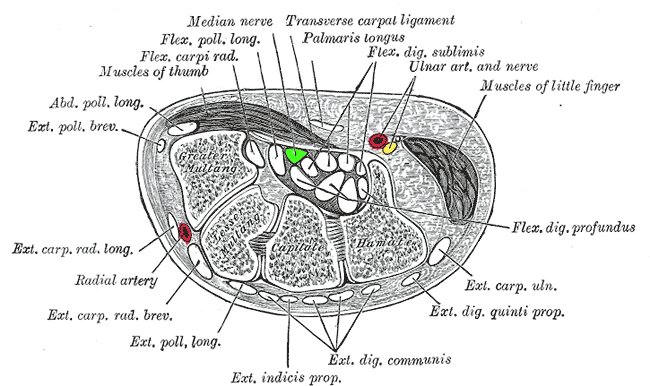Guyon's Canal
Syndrome
(aka Guyon's Tunnel Syndrome)
 What is
Guyon's Canal Syndrome?
What is
Guyon's Canal Syndrome?
Guyon's Canal Syndrome is a condition which usually arises
due to repeated pressure on the Guyon Canal or
overuse of repeated wrist motions which often results in
pinching or entrapment of the ulnar nerve in
the wrist (the yellow dot on the graphic at right).
What are the
Symptoms of Guyon's Canal Syndrome?
Common symptoms include
pins and needles in the 4th and 5th fingers, which
can over time become a burning sensation of pain in the
'non-thumb' portion of the wrist and hand. In severe
cases muscle weakness and reduced dexterity / impaired
mobility of the muscles on that side of the hand can occur.
What Causes Guyon's Canal Syndrome to
Develop?
Typically Guyon's Canal Syndrome can be
caused by activities which result in repetitive, steady
pressure on the outer edge of the hand (which pinches the
ulnar nerve). Some workplace activities which involve
continuous and repetitive wrist motions and pressure include
using conventional mice on a hard desk surface. This
arises because the outer edge of the palm and wrist often
'drags' on the mousing surface with most conventional mice
(which tend to be small and require Static
Grip Force to maintain control of while mousing).
Leisure activities which can cause this condition include
cycling (where the pressure from rigid handlebars can have a
similar effect).
What Activities and Movements Should be
Avoided if you have Guyon's Canal Syndrome?
Try to avoid
any direct pressure and
indirect pressure on the underside of the palm especially on
the 'outer' side of the hand/palm. Twisting laterally at
the wrist toward the 'pinky' side of the hand should also be
avoided (i.e. Ulnar
Deviation).
What Types of Products can be Used to
Help Prevent or Reduce the Symptoms and Incidence of
Guyon's Canal Syndrome?
Correctly sized Orthopedic
Mice which properly support the structure of the hand
in a neutral posture will help to prevent compression of the
Guyon Canal and can therefore be of significant
benefit. Separated
Keyboards, Adjustable
Keyboards and Fixed
Split Keyboards can help to prevent Ulnar
Deviation (lateral twisting at the wrist) when
keyboarding.

 What is
Guyon's Canal Syndrome?
What is
Guyon's Canal Syndrome?